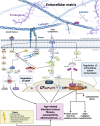Longevity-Promoting Pathways and Transcription Factors Respond to and Control Extracellular Matrix Dynamics During Aging and Disease
- PMID: 35874275
- PMCID: PMC9301135
- DOI: 10.3389/fragi.2022.935220
Longevity-Promoting Pathways and Transcription Factors Respond to and Control Extracellular Matrix Dynamics During Aging and Disease
Abstract
Aging is one of the largest risk factors for cancer, type 2 diabetes, osteoarthritis, cardiovascular diseases, and other age-related pathologies. Here, we give a detailed description of the interplay of chronic age-related pathologies with the remodeling of the extracellular matrix during disease development and progression. Longevity-promoting signaling pathways slow or prevent age-related diseases. In particular, we focus on the mTOR signaling pathway, sirtuins, and canonical longevity-promoting transcription factors, such as FOXO, NF-κB, and Nrf2. We extend our analysis using chromatin immunoprecipitation (ChIP) sequencing and transcriptomic data and report that many established and emerging longevity-promoting transcription factors, such as CREB1, FOXO1,3, GATA1,2,3,4, HIF1A, JUN, KLF4, MYC, NFE2L2/Nrf2, RELA/NF-κB, REST, STAT3,5A, and TP53/p53, directly regulate many extracellular matrix genes and remodelers. We propose that modulation of these pathways increases lifespan and protects from age-related diseases in part due to their effects on extracellular matrix remodeling. Therefore, to successfully treat age-related diseases, it is necessary to better understand the connection between extracellular matrix components and longevity pathways.
Keywords: FOXO transcription factors; NF-κB transcription factor; Nrf2 transcription factor; collagen; extracellular matrix; healthy aging; mTOR signaling pathway; matrisome.
Copyright © 2022 Vidović and Ewald.
Conflict of interest statement
TV is employed by Tinka Therapeutics. CYE is a co-founder and shareholder of Avea Life AG and is on the Scientific Advisory Board of Maximon AG and Galyan Bio, INC. The remaining author declares that the research was conducted in the absence of any commercial or financial relationships that could be construed as a potential conflict of interest.
Figures


Similar articles
-
Dauer-independent insulin/IGF-1-signalling implicates collagen remodelling in longevity.Nature. 2015 Mar 5;519(7541):97-101. doi: 10.1038/nature14021. Epub 2014 Dec 15. Nature. 2015. PMID: 25517099 Free PMC article.
-
The Matrisome during Aging and Longevity: A Systems-Level Approach toward Defining Matreotypes Promoting Healthy Aging.Gerontology. 2020;66(3):266-274. doi: 10.1159/000504295. Epub 2019 Dec 13. Gerontology. 2020. PMID: 31838471 Free PMC article. Review.
-
Genome-Wide Occupancy Profiling Reveals Critical Roles of FoxO1 in Regulating Extracellular Matrix and Circadian Rhythm Genes in Human Chondrocytes.Arthritis Rheumatol. 2020 Sep;72(9):1514-1523. doi: 10.1002/art.41284. Epub 2020 Aug 9. Arthritis Rheumatol. 2020. PMID: 32281255 Free PMC article.
-
DAF-16/FOXO Transcription Factor in Aging and Longevity.Front Pharmacol. 2017 Aug 23;8:548. doi: 10.3389/fphar.2017.00548. eCollection 2017. Front Pharmacol. 2017. PMID: 28878670 Free PMC article. Review.
-
Long live FOXO: unraveling the role of FOXO proteins in aging and longevity.Aging Cell. 2016 Apr;15(2):196-207. doi: 10.1111/acel.12427. Epub 2015 Dec 8. Aging Cell. 2016. PMID: 26643314 Free PMC article. Review.
Cited by
-
Circadian Clock Desynchronization and Insulin Resistance.Int J Environ Res Public Health. 2022 Dec 20;20(1):29. doi: 10.3390/ijerph20010029. Int J Environ Res Public Health. 2022. PMID: 36612350 Free PMC article. Review.
-
Cellular rejuvenation: molecular mechanisms and potential therapeutic interventions for diseases.Signal Transduct Target Ther. 2023 Mar 14;8(1):116. doi: 10.1038/s41392-023-01343-5. Signal Transduct Target Ther. 2023. PMID: 36918530 Free PMC article. Review.
-
Signaling circuits and the apical extracellular matrix in aging: connections identified in the nematode Caenorhabditis elegans.Am J Physiol Cell Physiol. 2023 Nov 1;325(5):C1201-C1211. doi: 10.1152/ajpcell.00195.2023. Epub 2023 Sep 18. Am J Physiol Cell Physiol. 2023. PMID: 37721005 Free PMC article. Review.
-
Extracellular Matrix Dynamics as an Emerging yet Understudied Hallmark of Aging and Longevity.Aging Dis. 2023 Jun 1;14(3):670-693. doi: 10.14336/AD.2022.1116. Aging Dis. 2023. PMID: 37191434 Free PMC article. Review.
-
Longevity interventions modulate mechanotransduction and extracellular matrix homeostasis in C. elegans.Nat Commun. 2024 Jan 4;15(1):276. doi: 10.1038/s41467-023-44409-2. Nat Commun. 2024. PMID: 38177158 Free PMC article.
References
Publication types
LinkOut - more resources
Full Text Sources
Research Materials
Miscellaneous

